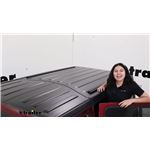
Yakima RibCage Custom Track System for Jeep Wrangler JL Unlimited Hardtop

- All Info
- Q & A (0)
- Videos (1)
- Photos
Yakima Roof Rack - Y52UV
- Tracks
- 2 Pack
- Yakima
- 48 Inch Track Length
If you're adding a roof rack to carry gear for outdoor adventures, start with a strong foundation. Heavy-duty tracks mount to your Jeep's hardtop and utilize the factory sports bars to let you carry loads up to 330 lbs, even off-road.
Features:
- RibCage system lets you add reinforced tracks on the hardtop of your Jeep
- Pair with Yakima towers and a platform or crossbars (sold separately) to create a complete system
- Support brackets increase the off-road weight capacity of your roof rack system
- Custom installation on your Jeep's hardtop - drilling required
- Brackets attach to tracks and bolt to your factory sports bars to stabilize the system
- Freedom Panels can still be removed while tracks are installed
- Rugged construction designed for off-road use and tested in harsh conditions
- Durable aluminum with black powder coat resists corrosion
Specs:
- Application: Jeep Wrangler JL Unlimited Hardtop
- Weight capacity: up to 330 lbs on-road and off-road
- Track dimensions: 48" long x 2" wide x 7/8" tall
- Track weight: 4 lbs
- Limited lifetime warranty
8001052 Yakima RibCage Roof Rack Mounting System for Jeep Wrangler JL
Installation Details

Videos are provided as a guide only. Refer to manufacturer installation instructions and specs for complete information.
Video Transcript for Yakima RibCage Custom Track System for Jeep Wrangler JL Unlimited Hardtop Reveiw
Hi, everyone, it's Evangeline right here at etrailer. Today, we have the Yakima RibCage. This is a very custom fit system for your Jeeps. We're gonna take a look at it here on the Jeep Wrangler or the Jeep JL Unlimited, but this will also fit your Jeep JK. This is going to give you a lot of extra capacity compared to other systems that install onto your hard top. We'll take a look at its features right here.
There are a ton of roof rack options for your Jeeps. You have your temporary options where they mount to your gutters, making it super easy to put on and take off, but those usually have less weight capacity. Then you have your roof racks and platforms I install into your roof. Yakima even has their tracks that install onto your hard tops. However, what makes the Yakima RibCage different is that it not only installs on your roof, but it installs through your roof and gives you extra, extra weight capacity using brackets and struts inside your Jeep.
At a first glance, you won't even notice that anything is installed. All the brackets and struts are very low profile, and they utilize a lot of the mounting spots that are already on your Jeep's roll cage. So you can see how this is supporting our top track from the front of our roll cage, and you also have the rear struts supporting the weight from the back of the cage. This all adds up to a weight capacity of 330 pounds on-road and off-road. That off-road number is very impressive.
A lot of other roof rack systems don't get near that much weight capacity, and they decrease that even more once you start using your Jeep for Jeep things. With that in mind too, that 330 pounds is very helpful when you start carrying those heavier items like those platforms or those trays. We utilize these tracks that can be used with those streamlined towers or the Yakima LockNLoad platform. The tracks can carry different types of towers and mounting brackets. We have an open end on the end caps.
You can just slide your hardware through without having to remove the end caps. Depending on what towers or platforms you use on top of here will change your actual weight capacity. If you wanna fully utilize that weight capacity, get up to three towers there or use the LockNLoad platform. If you only use two towers, that's totally fine, but then you jump down to a 220-pound dynamic weight capacity. And because of where those tracks are mounted, if you wanted to remove your freedom panels, that's totally an option for you. All of this is mounted to the rear part of your hard top. On the outside, looks like just any other roof rack track. Yes, it is a bit more sleek, and with its aluminum construction and it's nice finish, it is designed to stay on your vehicle for extended periods of time. It is heavy duty and it also looks good. On the inside, that's where it looks extra special. If you notice it, you do have those extra brackets and those struts holding things up but also tucked away out of notice. Where it gets very interesting though, is the installation process. I've installed a lot of roof rack tracks, things on camper shells, things on Jeeps, and usually they're a very involved process with a lot of measuring and a great risk of error. If you don't measure everything perfectly, you might end up drilling more holes than you want to. But because of how Yakima designs things, it's very straightforward, almost foolproof, and they make things a lot easier to do. Even if you're not someone that works on cars a lot, you might feel a bit more comfortable installing the Yakima RibCage, and that's gonna be where it's very different. If you just wanna do it once and you wanna do it by yourself and not have to pay someone to install, this might be at the easiest Jeep track system that there is on the market. Now, with that, it is gonna be a little bit pricier, but the effort and the hassle it saves might be worth it. So if you're really curious about that process, stick around, and I'll show you how I got it installed on our Jeep. What I really like about a lot of the install-heavy items from Yakima is that they are very intentional about their parts design. A lot of the things you're going to need are included with your RibCage set. You have the bars, you have the brackets, you have all the little nuts and bolts, and even the sealant is included. What's not included are going to be some of the tools which I have laid out here. So you're going to need a drill as well as a quarter inch drill bit. You're gonna need some measuring tape. You're gonna need an open-ended 10-millimeter wrench as well as a 17-millimeter wrench. You're going to need something that can mark spots. I also use a wrench and some bits that have Torx bits so I can easily install the tools, but you do have a Torx wrench included. Another thing you're gonna need to bring to the table is your plastic pry panel, and I use a box cutter to get access to our parts. And then for safety, I also recommend grabbing some safety glasses and a shop vac when you drill. Other than that, everything is pretty straightforward. Let's get to it. First, grab your wrench included and you're going to use this to remove your panels. You have your front panels here by your roll bars, and then you're going to have your rear panels behind your roll bars. You're going to use the small end of this wrench to remove the bolts holding that panel in place. There will be 10 of these screws by the way. So on each panel, there's three on the bottom, two on the top. What I do is I use a T25 Torx bit with a little wrench just because it's a lot easier to reach the bolts on top of with that. But once those screws are removed, you remove the panel by just pulling inward. Ideally, pull at the back, pull inward, and then up a little bit and that will pull out the clip up top. Do this carefully, but don't be afraid to put a little effort into it. And then once you're done, hold onto these panels and these screws, you'll be using them again later. Very similar process for the rear panels, although in our case here, we have a large over landing set up in the back, so we already have these panels removed. These may need to use that plastic pry piece though 'cause they're a little tricky to take off the first time. Now get your front supports, and these are gonna need to be loosened with the large side of your wrench. Loosen it so that you can easily adjust your front supports. To attach those front supports, you're gonna have these blocks and then these bolts, and the location for them is gonna be all the way over here near the door. And then the other hole is over here on the inside. That inside one, super easy to drop in. That outside one though, I have pretty small hands and even then I can just barely fit in through underneath that hard top. You're gonna have to get that to drop in, then you attach your support. Fit this up in the general spot where you put those blocks and then secure it with your large bolts. Your bolts will go up and hand tighten into the nut on that support. Now these are support struts, so you want to push them up against your hard top and there's a little lip on the top of that that you need to line up like that. So as you hold that in place, you can now tighten down your bolts. I am using a T45 Torx bit because it's a lot easier that way. As you secure that support and you tighten down these bolts, you are gonna want these bolts to tighten down to 10 newton-meters. And the reasoning for that is so that you are firm up against the roof, and then you're going to tighten down your rear height adjustment to 5 newton-meters. So if you don't have a fancy torque tool like this that can tighten down to that spec, you can find one here at etrailer. You can also borrow one from your local parts shop, and 10 millimeters is gonna be at tight and then a little bit past that. You are going to drill some holes and you have this handy drill stop included. So this will be used first to measure where you put your drill bit in, have half an inch of drill bit sticking out. Then you're gonna grab that drill stop and fit it into the hole of the support bracket that you just installed. So it'll fit perfectly in that spot and you will use that and hold that up there as you bring your drill up to that hole and drill upwards. (drill whirring) Do that on both sides, and don't forget to vacuum up the debris on both holes. The hole you drilled on each side will be what you align your track to. Don't worry too much about this part, we're just fixing it into place to get our marker points. But to fix it into place, you're gonna need your M8 bolt and a rectangular washer. This is what's going to go in the top and that lines up with your arrows, and will secure to the large rectangular block underneath. Now you're gonna measure your tracks and make sure that everything is square. To do so, you first measure the front center and back sides of the tracks, making sure that you measure on the exact same part each time. So I have about 44 7/16 of an inch and that's gonna be the same all across the tracks. And then you're gonna go diagonally as well. So measuring from corner to corner, I had another person with me just double check that I was measuring on the exact corner. And if those measurements are going to be the same too, then you also know it's square. Do not use the roof itself as your base measurement because your Jeep roof is going to taper. You have to rely on the tracks to be square with each other. But once you have those measurements, go ahead and make those marks in those holes because that's where you're going to be drilling. I know it's tempting to drill straight through the tracks, but you do not want to scratch up those pre-made holes in there. You're going to remove the hardware, the bolt and the washer that was holding that track into place, and you're going to rely on the marked holes that you made. You are also going to remove those support struts that you installed earlier. And I know we torqued them out and everything, but you're gonna just have to torque them all again when you put them back. So once these are removed, you'll then have that clear shot at drilling down from the roof. This time we're gonna use the large end of our drill stop. So I'm again reinserting the drill bit, making sure it's between 1/4 inch to 3/4 inches past that drill stop. We're going back to half an inch. And let's get started. As you're drilling these holes, your Jeep roof is gonna be made of fiberglass, so take your safety precautions. I don't like how itchy fiberglass gets when it gets on my skin, so I definitely have myself all bundled up with some nitrile gloves, some eyes and breathing protection, but you're going to use that drill stop to drill all your holes. (drill whirring) After you vacuumed up all the holes you've drilled, what I do is I back in the top and the bottom just so that there's no fiberglass shavings floating around. You're then going to reinstall those support brackets. Remember how you torque down the rear height adjustment We'll go ahead and make sure that your front height adjustment is a 16th of an inch shorter than the rear. If you don't do that, then it'll be really tricky to get that to fit into that ledge up top. You are gonna reinsert this, making sure it lines up both with the holes for your bolts underneath, but also the hole that you drilled earlier in this install. We're going to reinstall the tracks. So what I do to make this a bit faster and easier is I first put the rubber grommets and these push in from underneath the track. Once you've done that for all the holes on the track, I then get the bolts making sure it has a rubber washer on the inside, that's gonna fit into all those holes. We will seal all our holes with the included silicone. This should be enough to cover all the holes, but if you do happen to need more, we have a larger tube of this available here at etrailer. I like to liberally cover the holes with a good bead of the silicone. For safety, I do like to use these black nitrile gloves, that way I don't get any on my skin, but that's just an extra option for you. Don't forget to double check for both your rubber washer and your rectangular washer and make sure that these are in the track. Having the bolts in the track makes it easier to drop the track into those holes, making sure everything lines up nicely and smoothly. Push those bolts in. And if it doesn't fully line up, that's why you keep the support arm underneath a little loose. You may need to wiggle that around to make sure that the bolts truly sit. Some of the bolts underneath won't have anything to thread into. So you're gonna have these cap nuts that you're going to use, and this will be put on the third and fourth from the rear. Tighten those around the track nuts. You may need to push down from above if you don't get enough thread. And finally, it's time to install our rear supports. So on these support bars, we're gonna have RR and RL, so rear left and rear right. We already have the left one installed, we'll install this right one together. We're going to line this up with our roll bar, but while we're down here, let's notice the way it should be oriented. So see how this pivots around and then see how these corners are clipped or shorter than the other ones. You want those shorter corners facing the front of your Jeep. What I did is I have a person up top with these small Allen key and he's pushing down on those bolts. So when I fit the bracket into the bolts from underneath, let's line them up right there. We're gonna have Joe thread them down. We don't have to fully tighten, but enough to secure. Securing it up top will make it a bit easier to loosen that jam nut. So we have a 17-millimeter wrench. We're gonna use this wrench to loosen that nut. And then we're going to bring this up. So we can adjust our strut up and down by holding onto this 10 millimeter nut at the top, which is different from that jam nut, by the way. We can then lower our strut down to where holes will line up with our roll bar spots. Make sure that fits. And then the jam nut will secure it, so bring that back down when you're ready. Secure the strut with your two larger bolts and then tighten down with your T45 wrench or your Allen key. Torque down those M8 bolts to 10 newton-meters. And then when that's all done, go ahead and tighten down that jam nut with your 17-millimeter wrench. Now you get to tighten all your bolts down, double checking every single bolt. Go ahead and use your torque wrench if you do have that. And then don't forget to put your panels back on. You are able to put these front panels on, but the rear ones for your roll bar, those are going to have to stay off. And that's it for the install of your Yakima RibCage. This install was specifically for the Jeep Wrangler JL. This will be a little bit different if you have the JK Wrangler. Also, this is a time where you would attach your towers or your LockNLoad platform. We have a full kit available here at etrailer with a platform and the RibCage included. Check that one out if you wanna see how the platform performs. But other than that, this was the setup and a look at the features of your Yakima RibCage for your Jeeps.
Info for this part was:






At etrailer.com we provide the best information available about the products we sell. We take the quality of our information seriously so that you can get the right part the first time. Let us know if anything is missing or if you have any questions.


























































Thank you! Your comment has been submitted successfully. You should be able to view your question/comment here within a few days.
Error submitting comment. Please try again momentarily.